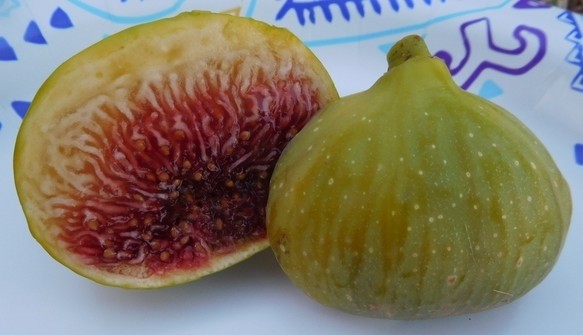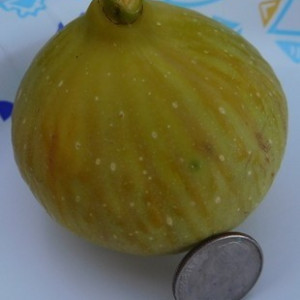This site contains affiliate links for which I may be compensated.
Kalamata
Kalamata Information


-
Possible Synonyms / AKA:
Kalamata Green, Kalamata White, Kalamon
Not the same as Calimyrna/Sari Lop
-
Introduced By:
-
Origin:
Greece -
Main Flavor Group:
Other - A unique combination of flavors, blending fruity, tropical, sweet, and acidic notes. This diverse profile creates a dynamic taste experience, often with hints of complexity and refreshing undertones. -
Family Group:
-
Fig Type:
Smyrna - Require caprification (pollination) to produce edible figs -
Cold Hardy:
N/A -
Container Variety:
Yes -
Easy Rooting:
N/A -
Main Season:
early -
Availability:
Difficult -
Breba Crop:
No -
Seed Crunch:
non -
Eye:
closed -
Skin Toughness:
soft -
Fruit Size:
Large -
Rain Resistance:
N/A -
Tree Vigor:
N/A -
External Links:
http://figs4funforum.arghchive.com/post/green-kalamata-greek-fig-prasinosika-kalamatas-7034051
https://www.ourfigs.com/forum/figs-home/570223-green-kalamata-and-sultani-aaron-s
https://www.ourfigs.com/forum/figs-home/186076-kalamata-green
Description
The Kalamon fig, often called Kalamata, is a traditional dessert-quality cultivar native to the Peloponnese in Greece—especially Messenia. Contrary to some outdated sources, this fig is not self-pollinating (“common type”), but rather a Smyrna -type fig, meaning it requires Caprification (pollination by the fig Wasp Blastophaga Psenes ) to develop full-size, edible fruit. If pollination fails, the immature figs typically drop or shrivel without ripening.
Kalamata fruits are known for bright green to yellow skin when fresh, aging to a golden to tan hue. Inside, the flesh is deep red to rose, resinous, and intensely sweet—especially when properly pollinated. The texture is dense and succulent, with a crunchy seed load if fully pollinated. These figs are predominantly grown for drying, making one of the most desirable dried fig cultivars in Europe.
By Greenfig 8-18-2017
Was introduced by Andreas. This is the first fig for me, only in a 2 gal pot. The taste was excellent! Very large fig, super juicy, crunchy seeds, berry flavor. Doesn't split, the eye is closed. I think in ground it will be a winner.
From jmrtsus:
Thanks to DNA testing that was done in this 2010 study: Genetic structure and differentiation in cultivated fig (Ficus carica L.) Mallikarjuna K. Aradhya • Ed Stover • Dianne Velasco • Anne Koehmstedt. We have some clarity on many figs. A part of the chart is generated in pics below. The chart shows Kalamata all by its lonesome underlined in red and Calimyrna underline in gold and show no connection to each other.
It should be noted that 132 fig types were examined and about 25% were the same plant as another. Is it any wonder we have a serious name games and people advocating for more every day. Once in a while we get to make a synonym disappear, this is one and that is a good thing. We have proof the Kalamata is a fig not related to the Sari Lop/Calimyrna twins.
The Kalamata fig is a Smyrna fig from Greece, it is shown in research documents in Condit’s 1950 work as a synonym of the Calimyrna/Sari Lop by another horticulturists so Condit listed it as it is his habit of with no firsthand knowledge he takes noted scholars word that it was just another Sari Lop/Calimyrna. This 2010 DNA testing has shown it is its own fig with Messenia as the only known synonym. No relationship at all to the Calimyrna/Sari Lop twins.
Was Condit wrong? No, because it met the definition of being synonymous with the other Horticulturist observations. In other words it visually appeared to be the same to them; however that is debatable as we will see with second sight.
From Condit’s Monograph 1955
Kalamata (syn. Messenia) a variety imported by the University of California from Athens, Greece, in 1930, and reported to be identical with the commercial fig of Kalamata. Panos Th. Anagnostopoulos, Athens, reports in a letter dated March 22, 1953, that the Kalamata fig is the same as Sari Lop of Turkey. See account by Condit (1924). Description is from figs produced at Riverside since 1933. Figs medium, spherical to obviate; neck very short and thick; ribs not prominent; eye large, open; surface somewhat glossy, with delicate bloom; white flecks large, conspicuous; skin green, unattractive, often discoloring and checking crisscross at maturity; pulp dark strawberry; flavor rich, sweet; quality good. Commercially it is inferior because of poor skin color, dark pulp, and tendency to split.
Kalamata = Calimyrna = Sari Lop
Below is from Condit's 1950 Sari Lop/Calimyrna description
“color golden yellow to light lemon yellow, attractive; meat white, 1/8 inch thick; pulp amber to light strawberry; flavor rich and sweet; quality excellent, both fresh and dried; seeds numerous.”
So according to Condit’s work a Kalamata is “Unattractive, pulp is dark strawberry, skin Green and quality good. It is also considered inferior for commercial use due to poor color, dark pulp, and splitting.”
But the description of the Calimyrna/Sari Lop is, “attractive, pulp is amber to light strawberry, Golden yellow to light lemon yellow, quality is excellent”
The Kalamata fig is a Smyrna fig from Greece, it is shown in research documents in Condit’s 1950 work as a synonym of the Calimyrna/Sari Lop by another horticulturists so Condit listed it as it is his habit of with no firsthand knowledge he takes noted scholars word that it was just another Sari Lop/Calimyrna. This 2010 DNA testing has shown it is its own fig with Messenia as the only known synonym. No relationship at all to the Calimyrna/Sari Lop twins.
Was Condit wrong? No, because it met the definition of being synonymous with the other Horticulturist observations. In other words it visually appeared to be the same to them; however that is debatable as we will see with second sight.
From Condit’s Monograph 1955
Kalamata (syn. Messenia) a variety imported by the University of California from Athens, Greece, in 1930, and reported to be identical with the commercial fig of Kalamata. Panos Th. Anagnostopoulos, Athens, reports in a letter dated March 22, 1953, that the Kalamata fig is the same as Sari Lop of Turkey. See account by Condit (1924). Description is from figs produced at Riverside since 1933. Figs medium, spherical to obviate; neck very short and thick; ribs not prominent; eye large, open; surface somewhat glossy, with delicate bloom; white flecks large, conspicuous; skin green, unattractive, often discoloring and checking crisscross at maturity; pulp dark strawberry; flavor rich, sweet; quality good. Commercially it is inferior because of poor skin color, dark pulp, and tendency to split.
Kalamata = Calimyrna = Sari Lop
Below is from Condit's 1950 Sari Lop/Calimyrna description
“color golden yellow to light lemon yellow, attractive; meat white, 1/8 inch thick; pulp amber to light strawberry; flavor rich and sweet; quality excellent, both fresh and dried; seeds numerous.”
So according to Condit’s work a Kalamata is “Unattractive, pulp is dark strawberry, skin Green and quality good. It is also considered inferior for commercial use due to poor color, dark pulp, and splitting.”
But the description of the Calimyrna/Sari Lop is, “attractive, pulp is amber to light strawberry, Golden yellow to light lemon yellow, quality is excellent”
If you'd like your banner to be shown here and throughout Fig Database, send us a message.















